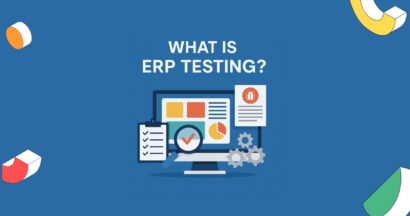ERP testing activities such as user acceptance testing are primarily concerned with making sure that specific business processes still work with updated software. As the enterprise IT landscape has become more and more complex, processes have started to touch multiple departments and applications – and end-to-end testing has become more relevant as a result.
In this blog, we’re going to talk about the importance of end-to-end testing, and how people like you, who are responsible for managing software testing, can do it as well as possible.
Table of contents
What is end-to-end testing?
End-to-end testing, sometimes called E2E testing, means fully testing a business process, no matter which applications and departments it touches. A good example to work with is to consider a bakery testing their order to fulfilment process – the entire process from a customer submitting an order, to the customer receiving their order.

Within that process, there are multiple steps:
- The customer has to place the order via the website
- The order has to be passed to the kitchen to be made
- The kitchen needs to pass the completed cake to logistics for deliver
- The logistics department needs to confirm that the customer has received the cake
In an enterprise-level organization, it’s quite likely that those steps take place within one ERP system, but with different teams responsible for different stages of the order. Some steps may go to other applications too (for instance, if the company uses a third party for delivering the cakes, and they transfer the order data via API).
It’s possible to test those steps individually – but doing so runs the risk of bugs slipping in at the point where the order moves from one team to another, or one application to another. That’s why end-to-end testing is vital. It plugs those gaps, strengthening your testing and ultimately delivering better software.
How to do end-to-end testing
The good news is that most people are already doing at least some of their testing end-to-end. After all, it’s highly logical – if you have a process that runs through multiple elements of the business, you test it all together.
In our experience, there are two main reasons why some organizations might not be doing end-to-end testing:
- They don’t have full visibility of some business processes, leading to only partial testing.
- The complexity of managing end-to-end testing gets the better of testing managers, breaking up the end-to-end nature of the testing.

End-to-end testing best practices
Gaining full visibility of business processes
If you don’t know a process (or part of it) exists, you can’t measure it. If, for instance, you didn’t know that submitting a sales order sends data to the marketing module of an ERP system as well as the manufacturing component, you would only test the transfer of data from sales to manufacturing. That introduces the risk that the flow of data to the marketing module – and whatever happens to that data once it gets to marketing – doesn’t work.
There are lots of expensive process mapping tools that you can use to document this sort of thing in great detail. But a simpler option can be to record your users doing their everyday work with a system that tracks everything they do, instead of building test cases based on assumptions or written notes. That way you’ll be able to spot everything that takes place in a specific process, with no need to rely on anyone’s memory.

Managing complexity
End-to-end testing is as much a timing game as anything, especially in industries that operate on principles such as just-in-time manufacturing. The time between an order being placed in one area of your ERP system, and it being scheduled for manufacture and delivery in other parts of the system, is a crucial factor in the success of the process.
But in a world where most ERP testing is still done on spreadsheets, managing that complexity can be hard. Sometimes you might find that a downstream element of the process is tested too early, or out of sequence, or even – perish the thought – forgotten entirely due to a tester being sick, or an email getting missed.
To get around this challenge, the best thing to do is to find a built-for-purpose test management tool. Tools like the Original Software Platform allow you to sequence the different test cases in a full end-to-end test, so that a user can’t start one until the previous tests have been completed. It also gives you a single view of test progress and who has been allocated which tests, making it much easier to identify any issues that might affect the timeline for your tests. Our tool can even automatically move data between different test cases, making it easy to test a process using a single set of data instead of having to recreate data for each state, or just using different data for each test case.
The beginning of the end-to-end?
If you’re interested in making sure that all your ERP software testing is genuinely end-to-end, we’d love to talk. Click here to get in touch and tell us what you’re working on, and we’ll arrange a time to speak and show you how we can help.











